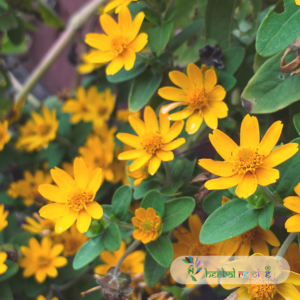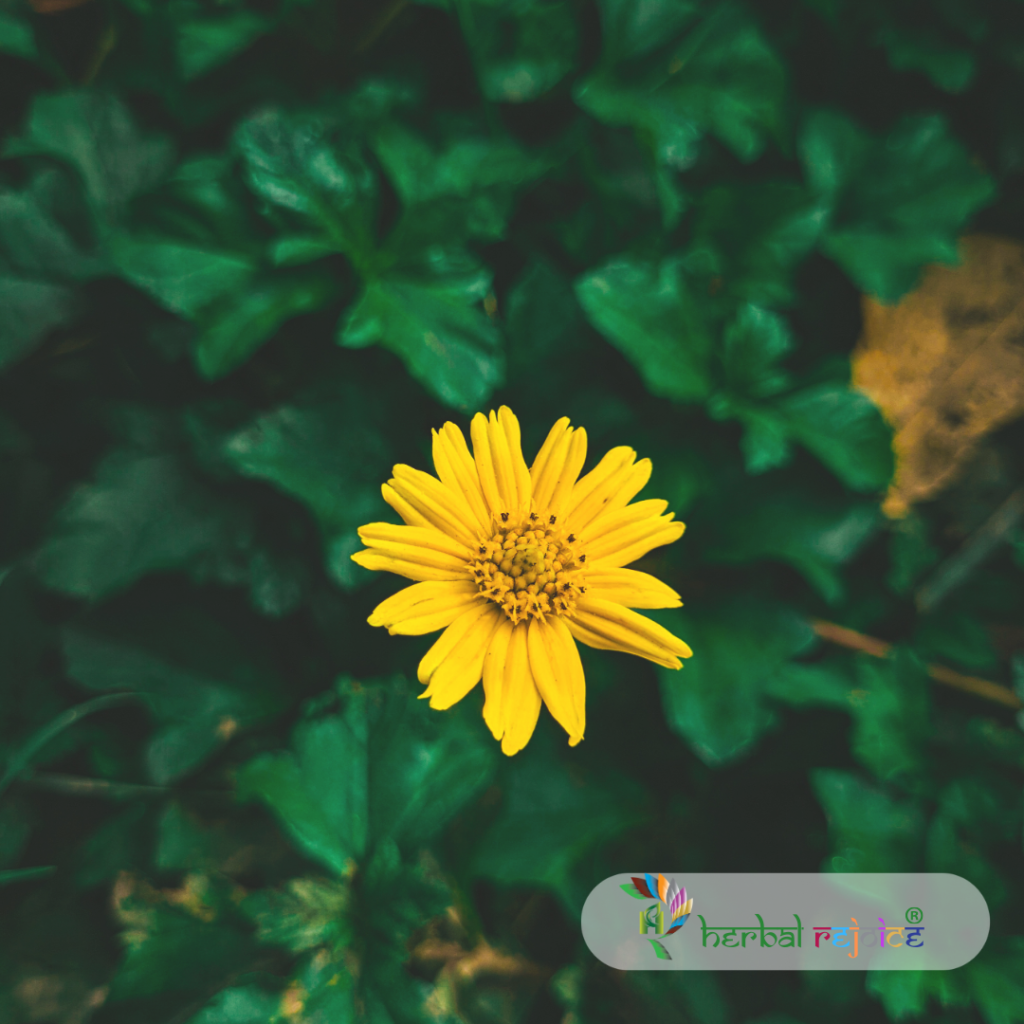Introduction
Wedelia calendulaceae Less. non-Rich is a plant belonging to the Compositae; Asteraceae family. It can be found in Bengal, Assam, Konkan, and Tamil Nadu. In Ayurvedic medicine, it is known as Bhringaraaja (yellowflowered var.), Pitabhringi, Pitabhringa-raaja, Avanti, Kesharaaja, Kesharaaga. In Siddha/Tamil medicine, it is known as Manjal karisaalai, Potralai kaiyan tagarai, Patalai Kaiantakerai.
Therauptic Potential
This plant has various medicinal properties. The leaves have bechic properties and are used in the treatment of alopecia. The juice of the plant is used for dyeing hair and promoting hair growth. The plant itself has deobstruent properties and is used in the treatment of menorrhagia and abdominal swellings. It is also used as a tonic for hepatic and splenic enlargement. It is worth noting that Eclipta alba, a similar plant, has similar medicinal properties.

Chemical Constituents
Wedelia calendulaceae contains several important constituents. The expressed juice of the plant contains an oil-soluble black dye, tannin, saponin (reports vary on the exact content), and phytosterol. The leaves also contain isoflavonoids. The fresh leaves have been found to contain bisdesmosidic oleanolic acid saponins. The plant also contains wedelolactone and demethyl wedelolactone, both of which have significant hepatoprotective activity. These compounds have been isolated from the methanol extract of the herb. Wedelolactone has been found to be a potent and selective 5-lipoxygenase inhibitor, functioning as an oxygen radical scavenger. Interestingly, wedelolactone is structurally similar to coumestrol, an estrogen found in Melilotus sp. (clover).
Conclusion
In conclusion, Wedelia calendulaceae, also known as Bhringaraaja or Pitabhringi, is a plant with various medicinal properties. It is used in Ayurvedic and Siddha/Tamil medicine for the treatment of alopecia, hair dyeing, hair growth promotion, menorrhagia, abdominal swellings, and hepatic and splenic enlargement. It contains important compounds such as an oil-soluble black dye, tannin, saponin, phytosterol, isoflavonoids, bisdesmosidic oleanolic acid saponins, wedelolactone, and demethyl wedelolactone. These compounds have hepatoprotective and 5-lipoxygenase inhibitor properties. Further research on this plant can potentially uncover more about its medicinal effects and applications.
Frequently Asked Questions
1. What family does Wedelia calendulaceae belong to?
Wedelia calendulaceae belongs to the Compositae; Asteraceae family.
2. Where can Wedelia calendulaceae be found?
Wedelia calendulaceae can be found in Bengal, Assam, Konkan, and Tamil Nadu.
3. What is Wedelia calendulaceae known as in Ayurvedic medicine?
In Ayurvedic medicine, Wedelia calendulaceae is known as Bhringaraaja (yellowflowered var.), Pitabhringi, Pitabhringa-raaja, Avanti, Kesharaaja, Kesharaaga.
4. What is Wedelia calendulaceae known as in Siddha/Tamil medicine?
In Siddha/Tamil medicine, Wedelia calendulaceae is known as Manjal karisaalai, Potralai kaiyan tagarai, Patalai Kaiantakerai.
5. What are the medicinal properties of Wedelia calendulaceae?
Wedelia calendulaceae has bechic properties and is used in the treatment of alopecia. The plant also has deobstruent properties and is used in the treatment of menorrhagia and abdominal swellings. It is also used as a tonic for hepatic and splenic enlargement.
6. What is the use of the juice of Wedelia calendulaceae?
The juice of Wedelia calendulaceae is used for dyeing hair and promoting hair growth.
7. What is worth noting about Eclipta alba?
Eclipta alba, a similar plant to Wedelia calendulaceae, has similar medicinal properties.
8. What are the important constituents in Wedelia calendulaceae?
Wedelia calendulaceae contains an oil-soluble black dye, tannin, saponin, and phytosterol. The leaves also contain isoflavonoids.
9. What compounds can be found in the fresh leaves of Wedelia calendulaceae?
The fresh leaves of Wedelia calendulaceae contain bisdesmosidic oleanolic acid saponins.
10. What compounds with hepatoprotective activity can be found in Wedelia calendulaceae?
Wedelolactone and demethyl wedelolactone are compounds found in Wedelia calendulaceae with significant hepatoprotective activity.
11. What is the structure of wedelolactone?
Wedelolactone is structurally similar to coumestrol, an estrogen found in Melilotus sp. (clover).
12. What is the function of wedelolactone?
Wedelolactone functions as a potent and selective 5-lipoxygenase inhibitor, functioning as an oxygen radical scavenger.
13. What are some of the medicinal applications of Wedelia calendulaceae?
Wedelia calendulaceae is used for the treatment of alopecia, hair dyeing, hair growth promotion, menorrhagia, abdominal swellings, hepatic and splenic enlargement.
14. Can Wedelia calendulaceae be used in Ayurvedic and Siddha/Tamil medicine?
Yes, Wedelia calendulaceae is used in both Ayurvedic and Siddha/Tamil medicine.
15. Are there any other plants with similar medicinal properties to Wedelia calendulaceae?
Yes, Eclipta alba is a similar plant with similar medicinal properties.
16. What are some common uses of Wedelia calendulaceae in Ayurvedic medicine?
Wedelia calendulaceae is commonly used for the treatment of alopecia, hair dyeing, and hair growth promotion in Ayurvedic medicine.
17. Does Wedelia calendulaceae have any effects on the liver and spleen?
Yes, Wedelia calendulaceae is used as a tonic for hepatic and splenic enlargement.
18. Are there any compounds in Wedelia calendulaceae that have antioxidant properties?
Yes, wedelolactone, a compound found in Wedelia calendulaceae, has significant antioxidant properties.
19. What are some of the regions where Wedelia calendulaceae can be found?
Wedelia calendulaceae can be found in Bengal, Assam, Konkan, and Tamil Nadu.


